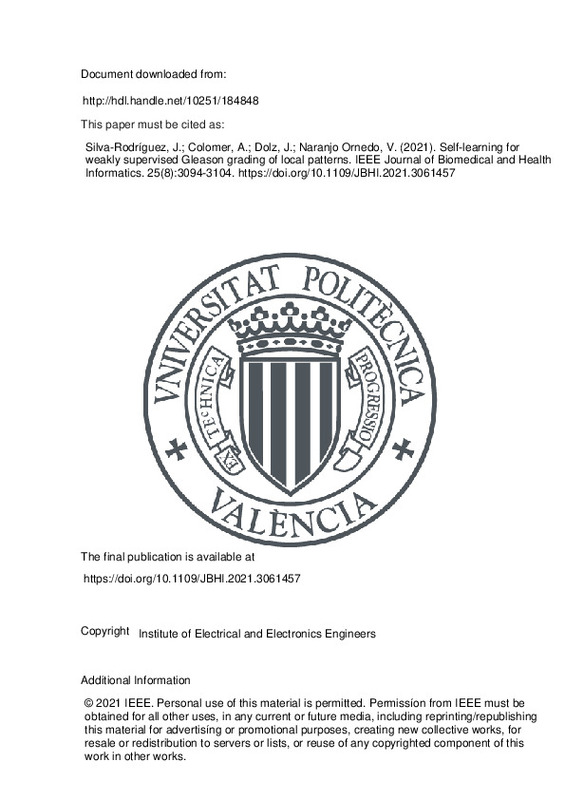JavaScript is disabled for your browser. Some features of this site may not work without it.
Buscar en RiuNet
Listar
Mi cuenta
Estadísticas
Ayuda RiuNet
Admin. UPV
Self-learning for weakly supervised Gleason grading of local patterns
Mostrar el registro sencillo del ítem
Ficheros en el ítem
| dc.contributor.author | Silva-Rodríguez, Julio
|
es_ES |
| dc.contributor.author | Colomer, Adrián
|
es_ES |
| dc.contributor.author | Dolz, Jose
|
es_ES |
| dc.contributor.author | Naranjo Ornedo, Valeriana
|
es_ES |
| dc.date.accessioned | 2022-07-27T18:05:44Z | |
| dc.date.available | 2022-07-27T18:05:44Z | |
| dc.date.issued | 2021-08 | es_ES |
| dc.identifier.issn | 2168-2194 | es_ES |
| dc.identifier.uri | http://hdl.handle.net/10251/184848 | |
| dc.description | © 2021 IEEE. Personal use of this material is permitted. Permissíon from IEEE must be obtained for all other uses, in any current or future media, including reprinting/republishing this material for advertisíng or promotional purposes, creating new collective works, for resale or redistribution to servers or lists, or reuse of any copyrighted component of this work in other works. | es_ES |
| dc.description.abstract | [EN] Prostate cancer is one of the main diseases affecting men worldwide. The gold standard for diagnosis and prognosis is the Gleason grading system. In this process, pathologists manually analyze prostate histology slides under microscope, in a high time-consuming and subjective task. In the last years, computer-aided-diagnosis (CAD) systems have emerged as a promising tool that could support pathologists in the daily clinical practice. Nevertheless, these systems are usually trained using tedious and prone-to-error pixel-level annotations of Gleason grades in the tissue. To alleviate the need of manual pixel-wise labeling, just a handful of works have been presented in the literature. Furthermore, despite the promising results achieved on global scoring the location of cancerous patterns in the tissue is only qualitatively addressed. These heatmaps of tumor regions, however, are crucial to the reliability of CAD systems as they provide explainability to the system's output and give confidence to pathologists that the model is focusing on medical relevant features. Motivated by this, we propose a novel weakly-supervised deeplearning model, based on self-learning CNNs, that leverages only the global Gleason score of gigapixel whole slide images during training to accurately perform both, grading of patch-level patterns and biopsy-level scoring. To evaluate the performance of the proposed method, we perform extensive experiments on three different external datasets for the patch-level Gleason grading, and on two different test sets for global Grade Group prediction. We empirically demonstrate that our approach outperforms its supervised counterpart on patch-level Gleason grading by a large margin, as well as state-of-the-art methods on global biopsylevel scoring. Particularly, the proposed model brings an average improvement on the Cohen's quadratic kappa (kappa) score of nearly 18% compared to full-supervision for the patch-level Gleason grading task. This suggests that the absence of the annotator's bias in our approach and the capability of using large weakly labeled datasets during training leads to higher performing and more robust models. Furthermore, raw features obtained from the patchlevel classifier showed to generalize better than previous approaches in the literature to the subjective global biopsylevel scoring. | es_ES |
| dc.description.sponsorship | This work was supported by the Spanish Ministry of Economy and Competitiveness through Projects DPI2016-77869 and PID2019-105142RB-C21. | es_ES |
| dc.language | Inglés | es_ES |
| dc.publisher | Institute of Electrical and Electronics Engineers | es_ES |
| dc.relation.ispartof | IEEE Journal of Biomedical and Health Informatics | es_ES |
| dc.rights | Reserva de todos los derechos | es_ES |
| dc.subject | Gleason grading | es_ES |
| dc.subject | Prostate cancer | es_ES |
| dc.subject | Self-learning | es_ES |
| dc.subject | Weakly supervised | es_ES |
| dc.subject | Whole slide images | es_ES |
| dc.subject.classification | TEORIA DE LA SEÑAL Y COMUNICACIONES | es_ES |
| dc.title | Self-learning for weakly supervised Gleason grading of local patterns | es_ES |
| dc.type | Artículo | es_ES |
| dc.identifier.doi | 10.1109/JBHI.2021.3061457 | es_ES |
| dc.relation.projectID | info:eu-repo/grantAgreement/AEI/Plan Estatal de Investigación Científica y Técnica y de Innovación 2017-2020/PID2019-105142RB-C21/ES/CARACTERIZACION DE NEOPLASIAS DE CELULAS FUSIFORMES EN IMAGENES HISTOLOGICAS/ | es_ES |
| dc.relation.projectID | info:eu-repo/grantAgreement/AGENCIA ESTATAL DE INVESTIGACION//DPI2016-77869-C2-1-R//SISTEMA DE INTERPRETACION DE IMAGENES HISTOPATOLOGICAS PARA LA DETECCION DE CANCER DE PROSTATA/ | es_ES |
| dc.rights.accessRights | Abierto | es_ES |
| dc.contributor.affiliation | Universitat Politècnica de València. Instituto del Transporte y Territorio - Institut del Transport i Territori | es_ES |
| dc.contributor.affiliation | Universitat Politècnica de València. Departamento de Comunicaciones - Departament de Comunicacions | es_ES |
| dc.description.bibliographicCitation | Silva-Rodríguez, J.; Colomer, A.; Dolz, J.; Naranjo Ornedo, V. (2021). Self-learning for weakly supervised Gleason grading of local patterns. IEEE Journal of Biomedical and Health Informatics. 25(8):3094-3104. https://doi.org/10.1109/JBHI.2021.3061457 | es_ES |
| dc.description.accrualMethod | S | es_ES |
| dc.relation.publisherversion | https://doi.org/10.1109/JBHI.2021.3061457 | es_ES |
| dc.description.upvformatpinicio | 3094 | es_ES |
| dc.description.upvformatpfin | 3104 | es_ES |
| dc.type.version | info:eu-repo/semantics/publishedVersion | es_ES |
| dc.description.volume | 25 | es_ES |
| dc.description.issue | 8 | es_ES |
| dc.identifier.pmid | 33621184 | es_ES |
| dc.relation.pasarela | S\429273 | es_ES |
| dc.contributor.funder | AGENCIA ESTATAL DE INVESTIGACION | es_ES |







![[Cerrado]](/themes/UPV/images/candado.png)

